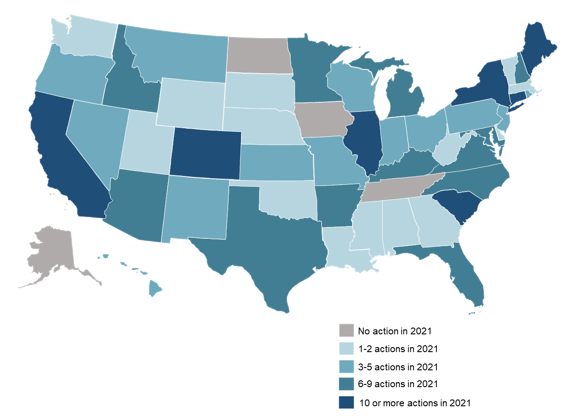The 50 States of Solar: States Eye Grid Access Fees, Time-Varying Rates, and Storage in Net Metering Successor Tariff Design During 2021
Raleigh, NC – (January 26, 2022) The N.C. Clean Energy Technology Center (NCCETC) released its 2021 annual review and Q4 update edition of The 50 States of Solar. The quarterly series provides insights on state regulatory and legislative discussions and actions on distributed solar policy, with a focus on net metering, distributed solar valuation, community solar, residential fixed charges, residential demand and solar charges, third-party ownership, and utility-led rooftop solar programs.
The report finds that 46 states and the District of Columbia took some type of distributed solar policy action during 2021 (see figure below), with the greatest number of actions relating to net metering policies, community solar policies, and residential fixed charge increases. The states taking the greatest number of actions Illinois, Maine, California, New York, Colorado, South Carolina, and Connecticut.
2021 Policy Action on Net Metering, Rate Design, and Solar Ownership

The report highlights ten of the top distributed solar policy trends of 2021:
- States showing support for time-varying distributed generation (DG) compensation structures;
- Utility proposals for grid access fees on the rise;
- Promoting low-income solar participation with carve-outs and incentives;
- Establishing distinct DG program designs for residential and non-residential customers;
- Reconsideration of additional fees for customer-generators;
- Increasing DG program system size limits and aggregate caps;
- Designing net metering successor tariffs with battery storage in mind;
- Considering new incentive programs as part of net metering decisions;
- Utilizing competitive procurement for community solar projects; and
- Continuing interest in DG compensation based on the value of solar.
“With regulators in Connecticut, Kentucky, New York, and South Carolina adopting new DG compensation tariffs, 2021 was a very consequential year for distributed solar,” noted Brian Lips, Senior Policy Project Manager at NCCETC. “But with major proposal under consideration in California, Hawaii, North Carolina, and other states, 2022 is shaping up to be even more eventful.”
A total of 286 state and utility level distributed solar policy and rate changes were proposed, pending, or decided in 2021. The report notes that ten of the most active states in 2021 for solar policy developments were:
- South Carolina, where regulators approved net metering successor tariffs featuring time-of-use netting, minimum bills, and non-bypassable charges.
- Connecticut, where the Public Utilities Regulatory Authority adopted two net metering successor options – a netting tariff and a buy-all, sell-all tariff;
- Kentucky, where the Public Service Commission rejected net metering successor designs proposed by three utilities;
- California, where utilities and stakeholders filed Net Metering 3.0 design recommendations and regulators issued a proposed decision in the proceeding;
- Illinois, where lawmakers enacted a major piece of energy legislation expanding incentive availability and modifying certain net metering and community solar rules;
- Maine, where legislators halted the state’s distributed generation procurement program and the Governor’s Energy Office convened a stakeholder group to consider program changes;
- New York, where regulators approved the addition of a customer benefit contribution to the net metering tariff and addressed a number of community solar issues;
- North Carolina, where Duke Energy filed a net metering successor tariff proposal resembling the tariff design recently approved in South Carolina;
- New Mexico, where lawmakers enacted legislation establishing a community solar program, the Public Regulation Commission working to develop program rules; and
- Michigan, where a distributed energy resources (DERs) rate design working group released a final report outlining possible paths for future DER rate design.
“This past year had the most DG charge-related actions we’ve seen since 2018. Although regulators in some states are removing DG fees, a trend toward DG capacity-based charges is continuing,” said Vincent Potter, Policy Analyst at NCCETC. “There were also several instances of multiple fees being proposed, such as minimum bills along with grid access charges. As utilities continue to assess the effects of distributed solar on their grids and revise their net metering rules, we expect to see more of these proposals in the future.”
In Q4 2021, 38 states and D.C. took some type of action on distributed solar policy or rate design. A total of 162 actions were tracked in Q4.
View the 50 States of Solar Q4 Quarterly Report and Annual Review Executive Summary
View and Purchase the 50 States of Solar 2021 Q3 Update FULL Report
View other 50 States Reports – Solar, Grid Modernization and Electric Vehicles
ABOUT THE N.C. CLEAN ENERGY TECHNOLOGY CENTER
The N.C. Clean Energy Technology Center, as part of the College of Engineering at North Carolina State University, advances a sustainable energy economy by educating, demonstrating and providing support for clean energy technologies, practices and policies. It serves as a resource for innovative, sustainable energy technologies through technology demonstration, technical assistance, outreach and training. For more information about the Center, visit: http://www.nccleantech.